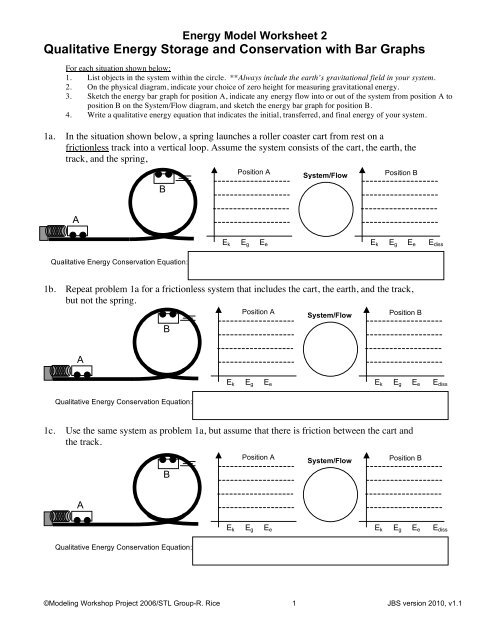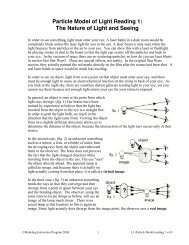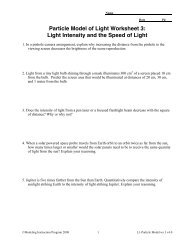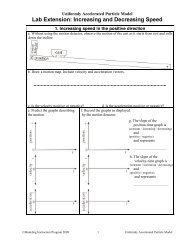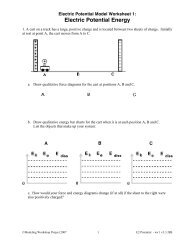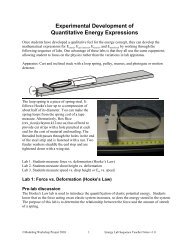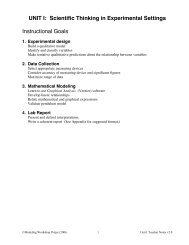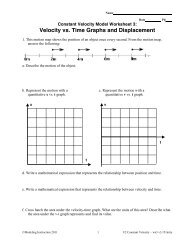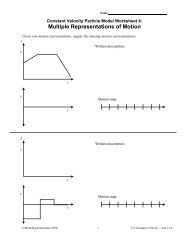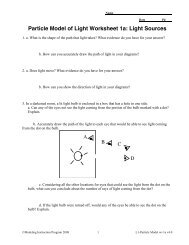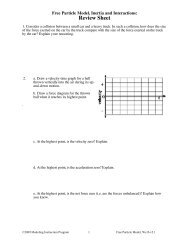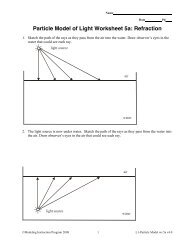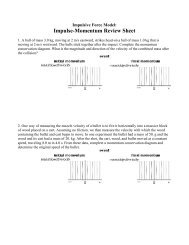Energy Model Worksheet2 BarGraphs - Modeling Physics
Energy Model Worksheet2 BarGraphs - Modeling Physics
Energy Model Worksheet2 BarGraphs - Modeling Physics
You also want an ePaper? Increase the reach of your titles
YUMPU automatically turns print PDFs into web optimized ePapers that Google loves.
<strong>Energy</strong> <strong>Model</strong> Worksheet 2<br />
Qualitative <strong>Energy</strong> Storage and Conservation with Bar Graphs<br />
For each situation shown below:<br />
1. List objects in the system within the circle. **Always include the earth’s gravitational field in your system.<br />
2. On the physical diagram, indicate your choice of zero height for measuring gravitational energy.<br />
3. Sketch the energy bar graph for position A, indicate any energy flow into or out of the system from position A to<br />
position B on the System/Flow diagram, and sketch the energy bar graph for position B.<br />
4. Write a qualitative energy equation that indicates the initial, transferred, and final energy of your system.<br />
1a. In the situation shown below, a spring launches a roller coaster cart from rest on a<br />
frictionless track into a vertical loop. Assume the system consists of the cart, the earth, the<br />
track, and the spring,<br />
B<br />
Position A<br />
System/Flow<br />
Position B<br />
A<br />
Qualitative <strong>Energy</strong> Conservation Equation:<br />
E k E g E e E k E g E e E diss<br />
1b. Repeat problem 1a for a frictionless system that includes the cart, the earth, and the track,<br />
but not the spring.<br />
B<br />
Position A<br />
System/Flow<br />
Position B<br />
A<br />
Qualitative <strong>Energy</strong> Conservation Equation:<br />
E k E g E e E k E g E e E diss<br />
1c. Use the same system as problem 1a, but assume that there is friction between the cart and<br />
the track.<br />
B<br />
Position A<br />
System/Flow<br />
Position B<br />
A<br />
E k E g E e E k E g E e E diss<br />
Qualitative <strong>Energy</strong> Conservation Equation:<br />
©<strong>Model</strong>ing Workshop Project 2006/STL Group-R. Rice 1 JBS version 2010, v1.1
1d. This situation is the same as problem 1a except that the final position of the cart is lower on<br />
the track. Make sure your bars are scaled consistently between problem 1 and 4. Assume<br />
the system consists of the cart, the earth, the track, and the spring.<br />
Position A<br />
System/Flow<br />
Position B<br />
A<br />
B<br />
E k E g E e E k E g E e E diss<br />
Qualitative <strong>Energy</strong> Conservation Equation:<br />
2a. A moving car rolls up a hill until it stops. Do this problem for a system that consists of the<br />
car, the road, and the earth. Assume that the engine is turned off, the car is in neutral, and<br />
there is no friction.<br />
y<br />
A<br />
B<br />
y B > 0<br />
v B = 0<br />
Position A<br />
System/Flow<br />
Position B<br />
y A = 0<br />
v A > 0<br />
E k E g E e E k E g E e E diss<br />
Qualitative <strong>Energy</strong> Conservation Equation:<br />
2b. Repeat problem 2a for the same system with friction.<br />
y<br />
A<br />
B<br />
y B > 0<br />
v B = 0<br />
Position A<br />
System/Flow<br />
Position B<br />
y A = 0<br />
v A > 0<br />
E k E g E e E k E g E e E diss<br />
Qualitative <strong>Energy</strong> Conservation Equation:<br />
3a. A person pushes a car, with the parking brake on, up a hill. Assume a system that includes<br />
the car, the road, and the earth, but does not include the person.<br />
y<br />
A<br />
B<br />
h B > 0<br />
v B = 0<br />
Position A<br />
System/Flow<br />
Position B<br />
h A = 0<br />
v A = 0<br />
E k E g E e E k E g E e E diss<br />
Qualitative <strong>Energy</strong> Conservation Equation:<br />
©<strong>Model</strong>ing Workshop Project 2006/A TIME for PHYSICS FIRST 2 JBS version 2010 v1.1
3b. Repeat problem 3a for a system that includes the person.<br />
y<br />
Position A<br />
B<br />
System/Flow<br />
Position B<br />
A<br />
h B > 0<br />
v B = 0<br />
h A = 0<br />
v A = 0<br />
E k E g E e E k E g E e E diss<br />
Qualitative <strong>Energy</strong> Conservation Equation:<br />
4a. A load of bricks rests on a tightly coiled spring and is then launched into the air. Assume a<br />
system that includes the spring, the bricks and the earth. Do this problem without friction.<br />
B<br />
y<br />
h B > 0<br />
v B > 0<br />
Position A<br />
System/Flow<br />
Position B<br />
A<br />
h A = 0<br />
v A = 0<br />
<strong>Energy</strong><br />
Equation:<br />
E k E g E e E k E g E e E diss<br />
4b. Repeat problem 4a with friction.<br />
B<br />
y<br />
h B > 0<br />
v B > 0<br />
Position A<br />
System/Flow<br />
Position B<br />
A<br />
h A = 0<br />
v A = 0<br />
<strong>Energy</strong><br />
Equation:<br />
E k E g E e E k E g E e E diss<br />
4c. Repeat problem 4a for a system that does not include the spring.<br />
B<br />
y<br />
h B > 0<br />
v B > 0<br />
Position A<br />
System/Flow<br />
Position B<br />
A<br />
h A = 0<br />
v A = 0<br />
<strong>Energy</strong><br />
Equation:<br />
E k E g E e E k E g E e E diss<br />
©<strong>Model</strong>ing Workshop Project 2006/A TIME for PHYSICS FIRST 3 JBS version 2010 v1.1
5a. A crate is propelled up a hill by a tightly coiled spring. Analyze this situation for a<br />
frictionless system that includes the spring, the hill, the crate, and the earth.<br />
y<br />
Position A<br />
System/Flow<br />
Position B<br />
B<br />
h B > 0<br />
v B > 0<br />
0<br />
A<br />
h A = 0<br />
v A = 0<br />
<strong>Energy</strong><br />
Equation:<br />
E k E g E e E k E g E e E diss<br />
5b. Repeat problem 5a for a system that does not include the spring and does have friction.<br />
y<br />
Position A<br />
System/Flow<br />
Position B<br />
B<br />
h B > 0<br />
v B > 0<br />
0<br />
6a. A bungee jumper falls off the platform and reaches the limit of stretch of the cord. Analyze<br />
this situation for a frictionless system that consists of the jumper, the earth, and the cord.<br />
y<br />
A<br />
A<br />
h A = 0<br />
v A = 0<br />
h A > 0<br />
v A = 0<br />
y<br />
<strong>Energy</strong><br />
Equation:<br />
E k E g E e E k E g E e E diss<br />
Position A<br />
System/Flow<br />
Position B<br />
0<br />
0<br />
B<br />
B<br />
h B > 0<br />
v B = 0<br />
E k E g E e E k E g E e E diss<br />
6b. Repeat problem 6a if the cord is not part of the system.<br />
y<br />
A<br />
h A > 0<br />
v A = 0<br />
y<br />
Position A<br />
System/Flow<br />
Position B<br />
0<br />
0<br />
B<br />
B<br />
h B > 0<br />
v B = 0<br />
E k E g E e E k E g E e E diss<br />
©<strong>Model</strong>ing Workshop Project 2006/A TIME for PHYSICS FIRST 4 JBS version 2010 v1.1


